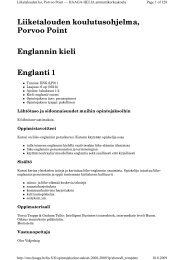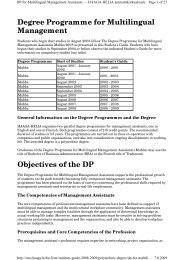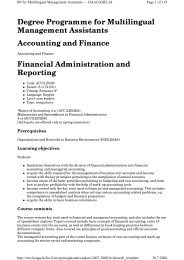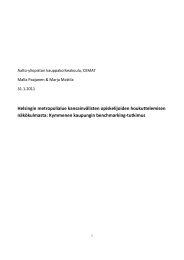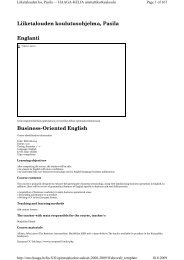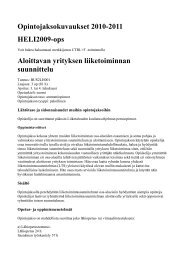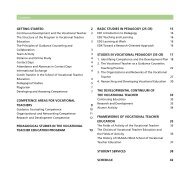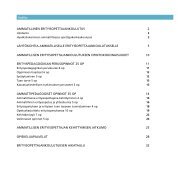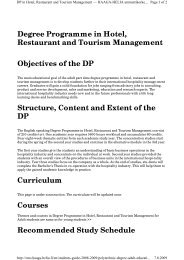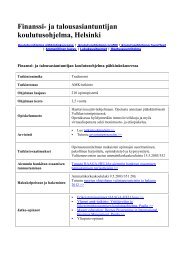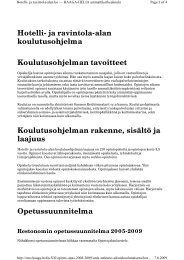Johdon assistenttityön ja kielten ko — HAAGA-HELIA ammattikor...
Johdon assistenttityön ja kielten ko — HAAGA-HELIA ammattikor...
Johdon assistenttityön ja kielten ko — HAAGA-HELIA ammattikor...
You also want an ePaper? Increase the reach of your titles
YUMPU automatically turns print PDFs into web optimized ePapers that Google loves.
<strong>Johdon</strong> <strong>assistenttityön</strong> <strong>ja</strong> <strong>kielten</strong> <strong>ko</strong> <strong>—</strong> <strong>HAAGA</strong>-<strong>HELIA</strong> ammatti<strong>ko</strong>rk...<br />
http://cms.haaga-helia.fi/fi/opinto<strong>ja</strong>ksokuvaukset-2009-2010/ls/showal...<br />
70 of 227 8.6.2010 12:43<br />
Extent: 6 cr (160 h)<br />
Timing: Period 4-5, Semester 1 (autumn 2008)<br />
Language: English/Chinese<br />
Level: free-choice studies<br />
Type: elective*<br />
* but required of students who have chosen compulsory Chinese<br />
Prerequisites<br />
No prerequisites.<br />
Learning outcomes<br />
Target level: A1.1<br />
Students<br />
know how to distinguish and pronounce the five tones in Mandarin Chinese<br />
get familiar with the Pinyin transliteration system<br />
know how to introduce themselves by stating their name, nationality, language skills, etc.<br />
can carry on some short superficial small talk<br />
get familiar with basic Chinese grammar<br />
learn the basics of reading and writing the most common Chinese characters<br />
Course contents<br />
the four main tones and the 5th toneless one<br />
the consonants and vowels of the Pinyin transliteration system<br />
vocabulary and sentence types from everyday conversation<br />
basic grammar rules on verbs, adjectives, sentence structure, etc.<br />
about 180 basic Chinese characters<br />
Chinese is the most spoken language in the world and one of the official languages of the UN. It is used<br />
officially in mainland China, Hong Kong, Taiwan, and Singapore. It is also used in Malaysia and the<br />
business world of Southeast Asia to a large extent. The Chinese language has had a great impact on East<br />
Asian languages and cultures. Thousands of Chinese characters have been borrowed by the Japanese<br />
language, and about 65% of Korean words have their origin in Chinese.<br />
Contrary to what many people believe, Chinese is not that difficult to learn. For example, the grammar is<br />
quite simple, the verbs are not conjugated and most words are short – only one or two syllables.<br />
Learning the Chinese characters takes time, but the graphic writing system is extremely interesting. The<br />
art of writing characters, i.e. calligraphy, is itself one of the most esteemed art forms in East Asia.<br />
According to the latest language research made by the Chinese Ministry of Education in 2007, only 581<br />
characters make up 80% of common Chinese texts. And if you know 934 characters, for whatever you<br />
might wish to read in Chinese, you can already recognize 90% of the characters.<br />
Teaching and learning methods<br />
Interactive classroom activities<br />
Individual and pair work<br />
Individual and pair studies on the Internet<br />
Mid-term and final exams<br />
There is a mandatory attendance of 80 %.



